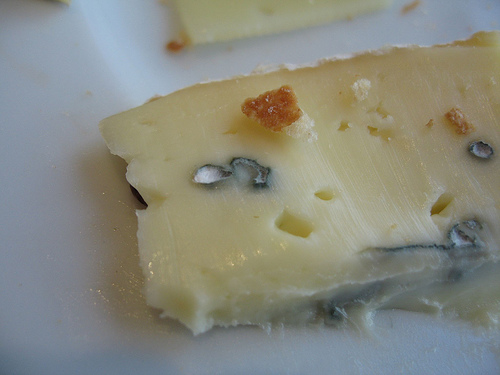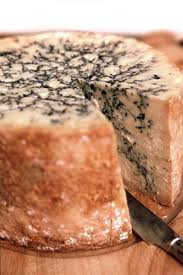Course:FNH200/2011w Team15 Cheese
Introduction

Cheese is a dairy product which is enjoyed by many people around the globe. Cheese is both made in Canada and imported to Canada from various countries. Cheese can be made from cow, goat, sheep, or buffalo milk. [1] Canada classifies cheeses into six categories based on moisture content. [1] These include firm, soft, semi-soft, hard, fresh and blue-veined cheese.[1] Some examples of cheese are mozzarella, chedder, parmesan and feta cheese. Cheese can be eaten by itself or with other food products such as crackers and toast. It is also used in preparing a variety of meals such as pizza, pastas and burgers.

Like any other food, cheese is associated with a variety of foodborne diseases and illnesses.Microbial growth is the major problem that will change the quality of cheese products. Mould on cheese can also be a problem depending on the cheese. Due to the safety concern, the Canadian government plays a huge role in regulating the production, importation and distribution of cheeses in Canada. Various safety measures are followed during the production and storage of cheese.Foodborne diseases and illnesses can be avoided if the government regulations and policies are strictly followed.
Moulds – safety risk or savoury?
Most of moulds produce spores and they are airborne all around us.[2] When one spore lands on the surface of cheese, it begins to reproduce rapidly like what yeast does under favorable conditions such as low pH and moist environment. Not only the condition in which the cheese is stored favours mould growth but also the density or types of cheese affect the penetration of mould in cheese. Cheese is classified into four types: soft, semi soft, semi hard or hard cheese.[1] The softer the cheese, the quicker the mold can grow on cheese. [2] The reason is that with the soft ones, the mould can easily send root threads throughout the cheese.[3]

Discard or do not eat: [3]
- Any cheese that is shredded, crumbled or sliced
- Brie
- Camembert
- Cottage cheese
- Cream cheese
- Neufchatel
- Ricotta
Not all moulds on cheese contaminate the product but also some of them produce great taste and aroma. For example, the mould spores are intentionally activated to the hard cheese such as blue cheese to produce rich flavor.[4] However, the presence of moulds after distribution should not be consumed but cutting the mold off the cheese is acceptable. Most of the time, the moulds cannot penetrate far into hard cheese so it can simply be removed about an inch from the growth.[5] After it is been cut off, it is safe to consume the rest of cheese. Also, it is important to make sure the knife does not come into contact with the rest of un-moulded cheese to prevent contamination.[5]

Ok to eat after mould is removed:[3]
- Asiago
- Blue cheese
- Cheddar
- Colby
- Gorgonzola
- Gruyere
- Parmesan
- Romano
- Stilton
- Swiss
Foodborne illness associated with cheese products
Cheese-making often involves introducing bacteria to dairy and other ingredients. Although these added bacteria may not make us ill, other disease-causing bacteria may be unintentionally introduced and may replicate during the cheese-making process. [6] Current local warnings and recalls of contaminated cheeses are sometimes reported in local news sources but accurate, detailed reports are maintained by the Canadian Food Inspection Agency at their website. [7]
Listeria monocytogenes: In regards to food-borne diseases associated with cheese, Listeria presents the highest severity and probability. It can grow well at pasteurization temperatures as well as during refrigeration. This bacterium is found most often in drains and surfaces of cheese factories, and in the water used for washing cheese, even when they have good sanitation practices. [8] Listeria is associated with a 30% mortality rate and may cause spontaneous abortion. [9] [10] To avoid listeriosis, Health Canada advises pregnant women children, older adults and people with weakened immune systems not to eat soft, mould-ripened cheeses, such as brie or camembert, blue-veined cheeses and others made from unpasteurized milk. [11] Cheese contaminated with Listeria monocytogenes may not look or smell unusual but, if consumed, may cause high fever, severe headache, neck stiffness and nausea. [12]
Salmonella: These bacteria are often present in raw milk but less often in cheese. However, they can grow in the cold temperature and the lower acidity of cheese. [10] This bacterium slowly declines during the ripening process but can last for several months. [10]
Staphylococcus aureus: This bacterium is a common contaminant in cheese and originates from raw milk or human contamination. However, it is easily suppressed by the reduced pH in cheeses. [10] Although this bacterium is killed during pasteurization, the toxins that it produces can survive processing. [8] Sorbate is used to inhibit the growth of S. aureus in processed cheese. [8]
Bacillus cereus, Clostridium butyricum, and Clostridium perfringens: These bacterium are a concern in dairy products due to their resistance to heat, growth at refrigeration temperatures, and the formation of spores. Although these bacterium may be killed during cheese processing, the spores can survive and harsher conditions are required to kill these.[8][10] Bacillus cereus can produce a pasteurization-resistant toxin that causes nausea, vomiting and diarrhea. Furthermore, the pasteurization process can actually promote the production of these spores. [10]
Eshericia coli O157 H7: This bacterium is more likely to contaminate raw milk and is a less likely post-pasteurization contamination concern. [8]
Campylobacter jejuni: This bacterium is also commonly found in raw milk but is destroyed during the heat processing and fermentation involved in cheese making. [10]
Yersinia enterocolitica: Studies show that although this bacterium is a frequent milk contaminant and is resistant to the cheese making process, outbreaks in Canada are rare. [10]
Ingredients that affect product safety
As previously stated, the three common food borne pathogenic bacteria are Listeria monocytogenes, Staphylococcus aureus, and Salmonella enterica. Growth of these bacteria during and after the manufacturing of various cheeses has caused food borne illness and contamination.[13] Thus the various ingredients in cheese making are not only used to enhance the flavor but also to prevent the food borne illness.[14]
The main ingredient of cheese is milk, which is very susceptible to contamination. By pasteurizing the milk, harmful bacteria and viruses are killed. However, the Pasteurization of milk to make cheese products is dependant on the type of cheese used. According to Health Canada, the sale of raw milk is prohibited; while raw milk cheese is not. This is due to the fact that the process which is used to make raw milk cheese will kill the harmful bacteria.[11] Therefore, pasteurizing of milk is not the only process to inactivate the pathogenic-disease causing bacteria, other ingredients also affect cheese product safety.
The most important step in cheese making process is the conversion of milk into solid form during fermentation of lactose or milk sugar to lactic acid and this is done by utilizing bacteria or acid.[15] Additionally, the most important factor that affects the growth of spoilage and disease-causing bacteria is the concentration of H+ or the acidity. Therefore, low pH does not only produce metabolic products and enzymes contributed to the aromas and flavors in different cheeses, but it also controls and preserves cheese from the growth of bacteria in order to increase their shelf life.[16] In order to lower the pH of the pasteurized and raw milk in cheese making, the Lactic acid-producing culture from Lactococci, Lactobacilli, or Streptococci families are added to milk. The starter culture converts the lactose or milk sugar into lactic acid. Studies showed that lactic acid also prevents the formation of botulinal toxin along with the reduction of pH; thus increasing the safety of cheese products.[8] Furthermore, Nisin produced by the bacterium Lactococcus lactis during fermentation exhibits the antibacterial activity and used as preservative in processed and cheddar cheese. Therefore, it enhances the safety and extends the shelf life of cheese products.[8]
Salt is another ingredient that has a very important role in cheese making which acts as an emulsifier and flavor enhancer. It does not only add flavor to the cheese, but also, it has the preservative property so the cheese will not spoil during processing or aging.[17] The water binding properties of salt lower the water activity, therefore, the growth of undesirable bacteria, toxin production, and enzymatic activities will decrease.[18]
Additionally, some studies have revealed that the extracts of some herbs and spices such as cinnamon sticks, oregano, clove, pomegranate peel and grape seed, that are utilized in some type of cheese products to provide particular aroma and flavor, stabilize the pH of the cheese products.[19] Since the extracts of these spices are rich in phenolic acid, flavonoids, and aromatic compounds, they have biological effects including antioxidants and antibacterial properties that may inhibit the growth of undesirable bacteria and increase the overall quality of the cheese products.[19]
Another important components of the milk used in cheese making is fat. Studies have shown that the level of fat affects the growth of bacteria in processed cheese. This may occur because the reduced-fat processed cheese products contain more ingredients to enhance the flavor which may have some antibacterial properties. Additionally, in processed-cheese products, fat may form a microenvironment that protects the bacteria from antibacterials. [8]. On the other hand, low-fat hard cheeses are more moist which support the growth of bacteria.[20].
Safety measures in production and storage
There are a few methods that cheese producers use to ensure the safety of the cheese product that they are manufacturing. The most effective procedure is a series of temperature treatments at varying stages of cheese production.
Temperature Treatments [21]
Pasteurization is process that raw milk must go through to be sold to the public; cheese is made from milk and most of the time that milk is also pasteurized. Pasteurization is a process that kills all disease causing bacteria by heating to between 72 and 73 ˚C for 15 to 20 seconds. Pasteurization is not required for any cheese that is intended to be aged for longer than one month, but generally the milk is pasteurized. Any cheese that is unripened or fresh must be pasteurized. Cheeses that do not begin with treated milk must undergo extra treatments to kill disease causing bacteria such as ripening for at least 60 days in a temperature of at least 4˚C. Most extra hard cheeses, such as Emmenthal and Parmesan, are made with pasteurized milk, but there is a risk of losing flavour at above 40˚C so the cows that these cheeses are produced from must be inspected frequently by veterinarians. There is much speculation over the effects of pasteurization on taste and texture of cheeses, but most manufacturers would prefer a slightly quality cheese being produced than to run the risk of allowing disease and spoilage bacterial growth.
The bacterial cultures that ferment the milk into cheese have optimal temperatures for production.
- Mesophillic cultures: have an optimal temperature range between 20 and 40˚C
- Thermophillic cultures: have an optimal temperature up to 45˚C
- Generally, a mixed strain of those cultures is used to promote optimum production of lactic acid, which both of the cultures produces. Lactic acid acidifies the cheese, so heat is also the limiting factor when lactic acid is produced in terms of acidity and size
- Rennet: has an optimal temperature around 40˚C but it is mostly used at lower temperatures to avoid excess hardness of the coagulated cheese.
Heat aids in the expulsion of whey from the cheese curd (syneresis)
Many ways to heat various cheeses
- Steam in a tank or a vat jacket
- Steam in a jacket when hot water had been added to the curd/whey mixture
- Hot water in the curd/whey mixture alone
Different temperatures are used for different cheeses and are have different names
- Cooking (above 40˚C)
- Stage 1: 37-38˚C, mesophilic lactic acid are slowed and production workers pause the heating to check the acidity of the curd
- Stage 2: heat above 44˚C and bacteria is deactivated (at 52˚C for 10-20 minutes kills bacteria)
- Scalding (above 44˚C)
- Emmenthal, Gruyere, Parmesan, Grana: between 50-56˚C
- Propionibacterium freudenreichii ssp. shermanii is one of the few that survive in these heating conditions and is essential to Emmenthal formation
Ripening- Different cheeses have different requirements for ripening temperatures and length
- Cheddar family: usually ripened at low temperatures (4-6˚C), then wrapped in a plastic film/bag then packed in cartons or wooden cases for transport; ripening takes 8-10 months depending on preferences of consumers
- Emmenthal cheeses: stored for 3-4 weeks in a room of 8-12˚C, then storage for 6-7 weeks in 22-25˚C room, then ripened at 8-12˚C for several months; Gouda is similar, but with slightly lower temperatures and there is a final step during ripening where the final Gouda characteristics are formed
- Smear cheese family: about 2 weeks at 14-16˚C where surface is smeared with cultured mix of salt solution, then ripened for 2-3 weeks in a 10-12˚C room
Storage[22]
Different cheeses have different shelf and storage lives despite heat treatments in production, below are some guidelines
- Fresh cheese: a few days to 2 weeks or more
- Soft cheese: 2 weeks in plastic wrap
- Semi-soft cheese: 2-4 weeks
- Firm cheese: 5 weeks to a few months
- Hard cheese: over one year
Note: these times are approximate based on when cheese was opened, and that the best before date should determine storage life
Government Regulations
In general, food safety is an important concern in Canada due to the risk of foodborne illnesses. Various government agencies, from federal to local, play an vital role in protecting the health of Canadians. In Canada, the Canadian Food Inspections Agency enforces the cheese safety standards and policies that are established by Health Canada in order to minimize the risk of foodborne illnesses.[23] The Canadian Food Inspections Agency also plays a role in enforcing veterinary health programs for dairy cattle and programs that protect Canadian livestock from diseases that could put human health at risk. [24] Furthermore, the Public Health Agency of Canada is in charge of conducting surveillance of disease outbreak related to food and epidemiology and provides advice to protect Canadian health. [23] Restaurant and food service inspections are also carried out by provincial and regional health authorities. [25] So government agencies ensure that Health Canada’s cheese safety requirements are met.
According to the Canada Agricultural Products Act, dairy products (including cheese) may not be imported, exported or traded between provinces unless the product is not contaminated, is edible, is prepared in sanitary manner and meets the dairy product requirements of the Food and Drugs Act and the Food and Drug Regulations. [26] The Food and Drug Regulations indicate what cheese shall be and what it may contain. Cheese shall “be the product made by coagulating milk, milk products or a combination thereof with the aid of bacteria to form a curd and forming the curd into a homogeneous mass after draining the whey…possess the physical, chemical and organoleptic properties for the variety,” and shall contain the maximum percentage of moisture, and contain no less and no more than the maximum percentage of milk fat for the particular variety. [27] Cheese may also contain numerous other ingredients (E.g. salts, seasonings, microorganisms to aid in further ripening, etc.) which all must be in present in specific amounts. [27]. Additionally, in order to import cheese, an importer must have a Canadian Food Inspection Agency issued cheese import licence. [28] These government regulations and standards for cheese are necessary for the safety of those that consume cheese.
In Canada, raw milk cheese which is made from unpasteurized milk is allowed to be distributed and sold. [11] Although through the manufacturing and production of raw milk cheese, bacteria harmful to the health are eliminated, certain people such as pregnant women, children, seniors and those with weak immune systems are encouraged not to eat it. [11]
So the Canadian Government intervenes from the initial steps of cheese making to the distribution of the cheese or the cheese product to the consumer. The government has strict policies and regulations when it comes to cheese safety. The establishment and enforcement of these policies and regulations by the government minimize the risk of foodborne illnesses and protect the health of Canadians.
Cheese Rolling Safety
Cheese is used mainly for the purpose of food, but it is also used for the leisure activity of cheese rolling. If proper safety measures are not followed, cheese rolling can lead to injuries ranging from minor sprains to major head injuries. Although not necessary, those engaging in this activity should wear helmets, knee-pads, and elbow pads for their safety. By using some form of protective gear, a person participating in cheese rolling can minimize the risk of injury. It is also a good idea to have paramedics present when cheese rolling is taking place. For a different type of risk associated with cheese, watch the video below.
References
- ↑ 1.0 1.1 1.2 1.3 Canadian Dairy Information Center. 2011. Canadian Cheese Directory. Retrieved from http://www3.agr.gc.ca/apps/cheese_info-fromage_infos/op-po_eng.cfm.
- ↑ 2.0 2.1 eHow.1999-2012. How does Mould grow on Cheese? Retrieved from http://www.ehow.com/how-does_5384755_mold-grow-cheese.html.
- ↑ 3.0 3.1 3.2 Mayo Clinic. Feb 26, 2011. Nutrition and Healthy Eating. Retrieved from http://www.mayoclinic.com/health/food-and-nutrition/AN01024.
- ↑ eHow Food.1999-2012.Why does Blue Cheese have Moulds in it? Retrieved from http://www.ehow.com/how-does_5194628_blue-cheese-mold-it_.html.
- ↑ 5.0 5.1 Food Editorials.com. 2012. Is Cheese with Molds Safe or Not. Retrieved from http://www.streetdirectory.com/food_editorials/snacks/cheese/is_cheese_with_mold_safe_or_not.html
- ↑ Food Safety and You. 2012. Retrieved from http://www.food-safety-and-you.com/Cheese.html
- ↑ Canadian Food Inspection Agency. 2012. Food Recalls and Allergy Alerts. Retrieved from http://inspection.gc.ca/english/corpaffr/recarapp/2011/20111213e.shtml
- ↑ 8.0 8.1 8.2 8.3 8.4 8.5 8.6 8.7 Glass K., Doyle M. 2005. Safety of processed cheese: A review of the scientific literature. Food Research Institute. University of Wisconsin. Retrieved from http://fri.wisc.edu/docs/pdf/ProcCheese.pdf
- ↑ Food Safety and Cheese. Dairy Research and Information Center. Department of Food Science & Technology. University of California, Davis. Retrieved from http://drinc.ucdavis.edu/dfoods5_new.htm
- ↑ 10.0 10.1 10.2 10.3 10.4 10.5 10.6 10.7 The Ontario Cheese Society. 2012. Cheese Safety Series. Retrieved from http://www.ontariocheese.org/cheese_safety/cheese_safety_5.php
- ↑ 11.0 11.1 11.2 11.3 Health Canada. 2011. Tip Sheet for Raw Milk. Retrieved from http://www.hc-sc.gc.ca/fn-an/securit/kitchen-cuisine/raw-milk-lait-cru-eng.php.
- ↑ Canadian Food Inspection Agency. 2012. Causes of Food Borne Illness. Retrieved from http://inspection.gc.ca/english/fssa/concen/cause/listeriae.shtml
- ↑ Planzer, Jr, S B., da Cruz, A G., Sant'ana, A S., Silva, R., Moura, M R L., de Carvalho, L M J. 2009. Food Safety knowledge of cheese consumers. Journal of food science 74: M28 - M30
- ↑ Anonymous. 2008. Cheese Making. Appropriate Technology 35: 52
- ↑ Zimbio. 2012.Curdling Cheese. Retrieved from http://www.zimbio.com/Cheese/notes/1/Curdling+Cheese
- ↑ Welcome To Our Cheese Site Written and maintained by Professor Arthur R. Hill. Dept. of Food Science, University of Guelph, Canada. Retrieved from http://www.foodsci.uoguelph.ca/cheese/sectionb.htm
- ↑ Salt and Cheese. 2004. Retrieved from http://www.britishcheese.com/userfiles/file/Salt___Cheese.pdf
- ↑ Guinee, T.P. 2004. Salting and the role of salt in cheese. International Journal of Dairy Technology 57: 99-109
- ↑ 19.0 19.1 Brooks, J. D., Cai, Yi-Zhong., Corke, H., Shan, B. 2011. Potential application of spice and herbs extracts as natural preservatives in cheese. School of Biological science. The university of Hong Kong
- ↑ Trickett, Jill. 2001. The prevention of food poisoning. Fourth Ed. Retrieved from http://books.google.ca/books?id=FW2gNgetJOcC&pg=PA85&lpg=PA85&dq=low+fat+cheese+and+microbial+growth&source=bl&ots=YFkl9GP8yI&sig=tBwhydjtNc15GVlBJ_Etxt-x4Uo&hl=en&sa=X&ei=3mdpT6f2NuObiQK1z7icBQ&ved=0CFUQ6AEwBw#v=onepage&q=low%20fat%20cheese%20and%20microbial%20growth&f=false
- ↑ United Kingdom Food-Info: Cheese Production. 2012. Retrieved from http://www.food-info.net/uk/dairy/cheese-production.htm
- ↑ Dairy Goodness: Shelf life of cheese. 2012. Retrieved from http://www.dairygoodness.ca/cheese/how-to-store-cheese/shelf-life-of-cheese
- ↑ 23.0 23.1 Public Health Agency of Canada. 2011. Food Safety. Retrieved from http://www.phac-aspc.gc.ca/fs-sa/index-eng.php.
- ↑ Canadian Dairy Information Center. 2011. The Canadian Dairy Industry at a Glance. Retrieved from http://www.dairyinfo.gc.ca/index_e.php?s1=cdi-ilc.
- ↑ Food Safety. 2011. Roles in Food Safety:Government. Retrieved from http://www.foodsafety.gc.ca/english/fssa/role.asp#a.
- ↑ Department of Justice. 2012. Dairy Products Regulations (SOR/79-840). Retrieved from http://laws-lois.justice.gc.ca/eng/regulations/SOR-79-840/page-2.html#h-4.
- ↑ 27.0 27.1 Department of Justice. 2012. Food and Drug Regulations B.08.033. Retrieved from http://laws-lois.justice.gc.ca/eng/regulations/C.R.C.%2C_c._870/page-92.html#docCont.
- ↑ Canadian Food Inspections Agency. 2011. Canadian Import, Export and Interprovincial Requirements for Dairy Products. Retrieved from http://www.inspection.gc.ca/food/dairy-products/imports-exports/eng/1300214060169/1300214161699.